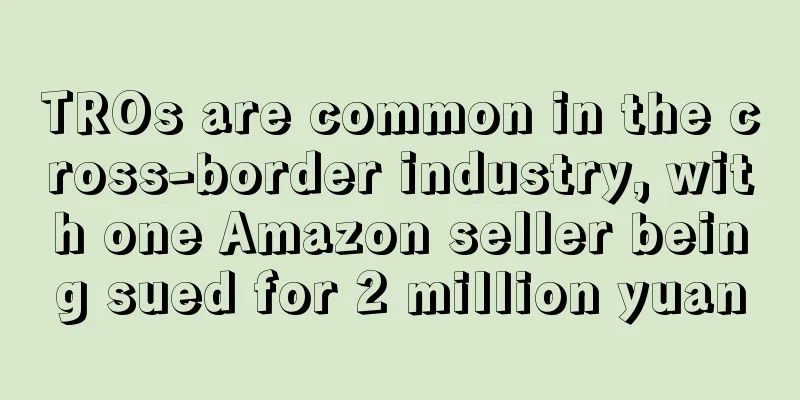What did he do right to achieve an annual income of over 100 million in 4 years?

|
Riding on the rapid development of the east wind, China's cross-border e-commerce has developed rapidly. According to the data of the General Administration of Customs, in the first quarter of this year, China's cross-border e-commerce imports and exports amounted to 577.6 billion yuan, an increase of 9.6%, of which exports amounted to 448 billion yuan. Driven by the wave of digitalization and the country's emphasis on brand overseas expansion, more and more DTC brands are turning their attention to overseas markets.
However, entering the international market is not a smooth journey. Under the baptism of different ecosystems, it is a tough battle to fight. At present, sellers generally report that orders have declined, even to the freezing point, and the cost of acquiring customers is also rising. This has a lot to do with the current situation of the overseas market. Inflation has made many consumers tighten their wallets, and consumption trends have changed suddenly. If overseas brands want to stand out, they will undoubtedly have to work hard on marketing.
Outrageous! 200,000 yuan advertising fee can't bring in orders
Recently, there have been more and more voices reflecting that advertising costs continue to rise while profits plummet. "The advertising budget has increased three times, but the number of orders is still a few," complained a seller on an independent website. In fact, there are many sellers who have the same experience. They usually spend a lot of money on advertising, but the number of orders remains the same. Recently, it has even fallen to the freezing point. The situation of extremely low ROI is common among brand sellers.
Many sellers have experienced the saying "throwing a stone into the water but not making a splash". Some sellers have invested 200,000 yuan in advertising fees before and after building an independent website, but all of it went to waste. However, there are also sellers who can earn multiple profits with only hundreds of thousands of yuan and make a lot of money. The difference is reflected in the key points of brand marketing: consumer insight and marketing.
Adobe data shows that the growth momentum of overseas e-commerce remains strong, with online spending reaching US$331.6 billion in the first four months of this year, a year-on-year increase of 7%. However, continued inflation has brought about a new phenomenon in overseas consumption : they are more inclined to buy low-priced products, and categories including personal care, electronics, clothing and furniture are their recent consumption focus.
Another key point is marketing. When DTC brands go overseas, localized marketing is the key to integrating into the local market and increasing brand awareness and influence, but the traditional price and exposure marketing model alone is no longer sufficient to achieve single-volume conversion. Marketing has gradually shifted from traffic to user-oriented, and more and more overseas brands have begun to explore the shopping paths of foreign consumers and seek a high ROI marketing model that deeply taps into consumer needs.
Multiple unicorns broke through the siege, what did they do right?
Looking at the overseas market, many Chinese sellers have failed in operating DTC brands. Even brands affiliated with major Internet companies have found it difficult to survive. However, in the cracks, there are still newcomers who continue to enter the public eye. They rely not only on the simple "selling goods" logic, but on their own marketing methodology.
Here, we take three leading DTC brands as cases to gain insight into their successful marketing strategies.
PatPat, a maternal and infant clothing brand known as the "SHEIN of children's clothing", is best at affiliate marketing, which is to reach a wider range of people through affiliate promotion to increase traffic and sales opportunities. PatPat, which is well aware of this, has already established cooperation with affiliate platforms including impact.com to customize appropriate commission plans. The basic commission of some affiliate platforms is as high as 12%, and the conversion rate is 0.22%.
FUNNY FUZZY, a pet DTC brand, started as an independent website. After one year of going global, it has accumulated millions of fans and has been ranked in the top 200 pet categories in the United States. As a new star in the pet industry, the key to FUNNY FUZZY's success is online marketing. Whether it is off-site link promotion, paid search, or social media, FUNNY FUZZY is involved. In addition, word-of-mouth maintenance is also the focus of its marketing. By publishing in-depth content, it strengthens consumers' awareness of the brand, builds brand power, and increases single-volume conversion. Currently, its annual revenue exceeds 100 million yuan.
The plus-size swimwear brand Cider mainly relies on KOL marketing, leveraging the traffic of celebrities and bloggers on various social media platforms to publish high-quality and professional evaluation content to promote products or brands to more users . In addition to PGC, Cider also uses UGC strategies to launch effective gameplay such as brand challenges on TikTok to reach user scenarios and finely enhance brand potential.
Brand sellers are well aware of the principle of "don't put all your eggs in one basket" in marketing. They often coordinate and cooperate through multiple marketing touchpoints such as social media, evaluation websites, review platforms, etc., to accurately resonate with users with high-quality and personalized content, stimulate their potential purchasing desire, and thus successfully make a name for themselves in the overseas circle.
However, due to multiple factors such as limited working capital and concerns about low investment-output ratio, some sellers are trying to reduce marketing cost budgets while increasing marketing. So for sellers, how can they do marketing to maintain a high investment-output ratio?
ROAS increased by 1499%, and some companies have already tasted the benefits
In the government work report released at this year's two sessions, one of the key points emphasized by the country is to create more influential Chinese brands. However, the current overseas market has undergone a qualitative change, from extensive to intensive cultivation. Compared with the explosive money-making ability of independent cross-border e-commerce sites in previous years, independent sites now appear a little thin due to the crowds of overseas platforms.
Sellers are generally in a dilemma: difficulty in attracting new customers, price fluctuations, and poor advertising investment accuracy. As a result, many independent website sellers are trapped in the anxiety of stagnant marketing and order volume.
The concept of partner marketing of impact.com solves the sellers' problems. Partner marketing includes various types such as alliance marketing, KOL marketing, partner content marketing, strategic B2B partner marketing, etc. The starting point of this marketing model is to deeply explore the invisible needs of consumers, break the barriers between brands and consumers through high-quality marketing matrix, and help sellers acquire customers efficiently through low-cost linkage, so that sellers can get rid of the anxiety of order volume while establishing a trust bond with consumers.
More and more sellers are using partner marketing to improve ROAS and achieve explosive sales. Take the British perfume brand Penhaligon's as an example. When its physical business was facing a large-scale decline, it switched to online sales and eventually achieved a 1499% increase in ROAS. It relied on partner marketing based on affiliate marketing.
On the one hand, brand marketing focuses on consumers, and builds trust and fit between consumers and brands through high-quality marketing content; on the other hand, it completes the conversion of orders through a diversified partner marketing matrix, which is a win-win situation. There are many successful cases of applying partner marketing. The retro fashion brand Homage has achieved a 485% increase in ROI through a partner marketing project with impact.com, far exceeding its peers.
It can be found that compared with the domestic market, foreign brands are more inclined to do marketing through various types of cooperation, such as brand partner programs, where consumers can get free products after passing the review, and product evaluations may eventually become a boost for consumers to purchase products.
In addition, traffic exchange between brands is also one of the hottest marketing methods at present. Last year, Luckin Coffee and Moutai jointly harvested a wave of traffic and also ushered in a surge in orders. Among the overseas brands, Cider is also a big traffic exchanger. It has jointly held activities on social media with European and American brands, and finally captured a large number of fans and paying users, achieving a win-win situation.
It is not difficult to see that foreign markets prefer a "cooperative" marketing model, but a single corporate force cannot quickly and accurately build its own cooperative marketing system. As a result, many brand overseas sellers will choose to cooperate with marketing management platforms to break the deadlock.
As the world's leading partner marketing management SaaS platform, impact.com has rich marketing resources inside and outside the platform, and has successfully expanded marketing channels for many domestic and foreign brands to achieve sustainable business growth. The book "Brand Overseas Marketing Practical Guide" recently launched from actual scenarios is a combination of different marketing methods. Through a large number of models and actual cases, it provides solutions for sellers who have ideas for overseas market layout and encounter business or marketing bottlenecks, enabling overseas brands to optimize partner marketing projects and achieve business growth efficiently.
Interested sellers can click the original text below the article to obtain the "Practical Guide to Brand Overseas Marketing" manual to learn more secrets of brand overseas marketing.
marketing Unit quantity impact |
<<: Miravia European Warehouse Merchant Invitation Meeting
>>: Too sudden! Shenzhen's best-selling products may be banned in the United States
Recommend
Amazon to test automated checkout technology
Amazon announced on Wednesday that it will introd...
Nordstrom eases pandemic financial burden with $675 million bond sale
The retailer plans to use the proceeds to repay $...
What is Cash App Pay? Cash App Pay Review, Features
Cash App Pay is the number one e-wallet in the Ph...
Best Buy's first-quarter profit fell 43%, but its stock price rose against the trend!
On May 24, Best Buy released its financial report...
What is China Merchants Hong Kong Finance Big Data Co., Ltd.? China Merchants Hong Kong Finance Big Data Co., Ltd. Review, Features
China Merchants Port Credit Big Data Co., Ltd. was...
How online e-commerce can help global economic recovery from the perspective of Shopify's mobile app Shop
Recently, Shopify President Harley Finkelstein sa...
Without relying on Amazon! Shenzhen sellers became the top sellers in the category in just 3 years
In recent years, the overseas demand for consumer...
eBay launches the "Large and Heavy Goods Premium Plan", Walmart releases this year's Q1 financial report
eBay launches "Large and Heavy Goods Premium...
Contactless spending in the UK grows 30%
On August 24, according to foreign media reports,...
What is Nejree? Nejree Review, Features
Nejree Saudi Shoe Mall was founded by Saudis in 20...
What is PayNow? PayNow Review, Features
PayNow is an electronic transfer service that allo...
What is Cross-border No.1 Store? Cross-border No.1 Store Review, Features
No.1 Cross-border Store is an online retail platfo...
Pinterest's fourth-quarter results far exceeded expectations with $706 million in revenue
Recently, financial reports have been released in...
Zhang Kuo, Alibaba International Station: The next stage of dividends for cross-border e-commerce may come from the digitization of the entire foreign trade process
Zhang Kuo, president of Alibaba International Sta...
"Amazon Global Store Cross-border Summit" will be held online in January 2022
"Branding Goods to the World, Winning with P...









